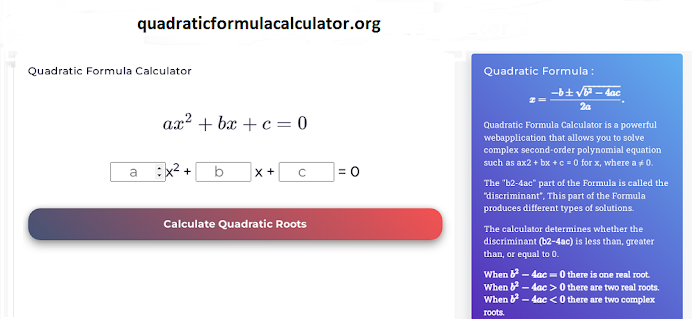Quadratic Formula Calculator
What is the quadratic formula?
A quadratic can be specified as a polynomial equation of degree 2, which contains at least one term whose square is. It is additionally called a quadratic equation. The general form of a quadratic equation is ax ² + bx + c = 0. where x is the unknown variable, and a, b, and c are mathematical coefficients.
How do I use the Quadratic Formula?
To use the quadratic formula, you need to:
Arrange your procedure in the form "( square) = 0".
Arrange the terms in descending order (the even term first, then the x-term,
and finally the consecutive term).
Draw the numerical parts of each of these terms, which are also the
"a," "b," and "c" of the formula.
Plug these numbers into the formula.
Make it easy to get your responses.
Hint: Every little thing above "2a" in the common denominator
of the formula is below, not just the square root. Also, it's a "2a"
down, not just a plain "2". Be careful not to leave the square root
or "plus/minus" in the middle of your calculations, or I guarantee
you will fail to remember to "put them back" on your exam. You will
mess yourself up. Note that "b2" means "the square of ALL of b,
including its sign," so if b2 is negative, don't drop b2 in the numerator,
even though b is unfavorable, since the square of the negative is favorable.
In other words, don't be careless and try to take the fast track because it will hurt you in the long run. Trust me on this one!
Nature of Roots of the Quadratic Equation
The origin of the quadratic formula is usually denoted by the symbols alpha (α) and beta (β). Here we will explore exactly how to find the form of the roots of a quadratic formula without finding the origin of the equation. And additionally, check the procedures to find the sum and term of the roots of the equation.
The form of the derivative of a quadratic equation can be found without
finding the root (α, β) of the formula. This discrimination is accomplished by
taking a value that forms part of the formula to address the class formula. The
value b2 - 4ac is called the discriminant of the quadratic equation and is
designated as 'D.' It can be estimated based on the differentiation of the form
of the roots of a quadratic equation.
Examples Of Quadratic Equation.
Example 2
Tips to Solve Equations reducible to Quadratic
To solve formulas of ax4 + bx2 + c = 0, put x2 = y.
To solve a.p(x) 2 + b.p(x) + c = 0, put p(x) = y.
a.p(x) + b/p(x) + c = 0 To solve, put p(x) = y.
To solve a(x2 + 1/x2) + b( x + 1/x) + c = 0, put x + 1/x = y and a( x2 +
1/x2) + b( x-- 1/x) + c = 0, let x-- 1/x = y.
To solve a reciprocal formula of the form ax4 + bx3 + cx2 + bx + a = 0, a
≠ 0, divide the formula by d2y/dx2 to get a( x2 + 1/x2) + b( x + 1/x). + c = 0,
and then put x + 1/x = y.
To solve (x + a) (x + b) (x + c) (x + d) + k = 0 where a + b = c + d, x2
+ (a + b) x = y put.
To solve a formula of the form √(ax + b) = cx + d or √(ax2 + bx + c) = dx
+ e, square both sides.
To solve √( ax + b) ± √( cx + d) = e, move from the radical to the
opposite side and square both sides. Place the expression with the extreme
addition on one side and move the rest to the other.
Roots of Quadratic Equation
The values of the variables that satisfy a given quadratic formula calculator are called its roots. In other words, x = α is a root of the quadratic formula f(x) if f(α) = 0.
The real roots of equation f( x) = 0 are the x-coordinates of the
elements where the contour y = f( x) intersects the x-axis.
One of the roots of the quadratic formula is zero, and the others are
different -b/a if c = 0.
Both have no roots if b = c = 0.
The origin is reciprocal to the various others if a = c.
Why is the helpful quadratic equation?
Specific quadratic formulas can be used to calculate values for both fixed and displacing objects or objects. In the case of moving objects, we can find their maximum height, the point they reach, their distance from specific issues at the corresponding time, etc. Also, quadratic equations are used to identify the profit or loss of the product.



Comments